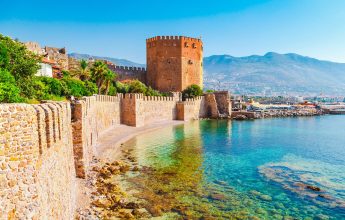Alanya in Details

Alanya in details
When the pirate domination ended with the Corakesion War, which resulted in the victory of the Roman Pompeius in 65 BC, the city grew with the expansion of the walls and the addition of new buildings during the Roman period.
Alanya Castle; During the Byzantine period, as Kalonoros, it became an important locating point for sailors and the busiest port in the Mediterranean.
The church in İçkale, the Arap Evliyası, the monastery ruins on the Cilvarda cape and the remains of the round towered city walls that continue from Orta Hisar to the İçkale belong to the Byzantine period.
Kalonoros in 1221; It was handed over to the Anatolian Seljuk Sultan Alaaddin Keykubat by the owner of the castle, Kyr Vart, and its name was changed to Alaiye.
I. Alaaddin Keykubat started a great reconstruction activity, he had new walls built as well as reinforcing the old walls.
Other structures built by I. Alaaddin Keykubat are as follows; large cisterns, shipyard, red tower, armory, palace complex in the Inner Castle.
Alaiye; In the first half of the 14th century, it was among the important cities of Anatolia and the Mediterranean as a leading trade city of the Anatolian Seljuks, an important naval base, a trade and shipbuilding center with strong relations with Egypt and Syria.
Alaiye; With the collapse of the Seljuk state, it passed into the hands of the Kingdom of Cyprus for a short time. After the Karaman and Alaiye Principalities, it came under Ottoman rule in 1471.
Turkey has 83 assets, 77 of which are cultural, 3 of which are natural and 3 of which are mixed (Cultural/Natural), on UNESCO’s World Heritage Tentative List.
Under the UNESCO Convention on the Protection of the World Cultural and Natural Heritage, States Parties are obliged to submit their inventories (temporary list) of assets eligible for inscription on the UNESCO World Heritage List to the UNESCO World Heritage Centre.
Candidacy files prepared for the assets included in this list published by the UNESCO World Heritage Center are submitted to the World Heritage Committee. While preparing the Tentative Lists, the conditions of the assets meeting the criteria determined by the World Heritage Committee and their architectural, historical, aesthetic and cultural, economic, social, symbolic and philosophical characteristics are also taken into consideration.
Our Tentative List, first submitted to the UNESCO World Heritage Center in 1994, was updated in 2000, 2009, 2011, 2012, 2013, 2014, 2015, 2016, 2017, 2018, 2019 and 2020.




